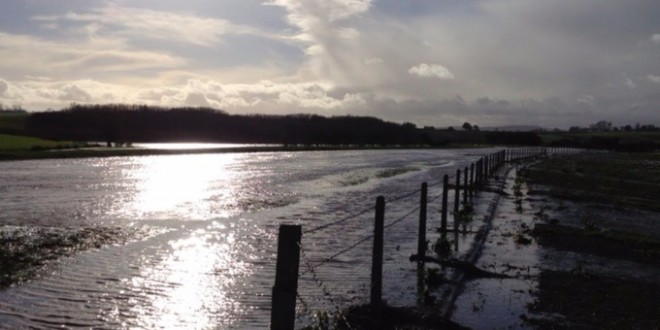The January 2014 flooding in the south-west and north-east of England was due to man-made climate change, say scientists from Oxford University. They say the stormiest period of weather the UK has experienced over the past 20 years occurred as greenhouse gases increased the risk of adverse weather.
They found that anthropogenic greenhouse gas emissions increased the risk of the once-a-century wet January in 2014 by 43% (uncertainty range: 0–160%). The increase in extreme rainfall that led to the flooding in 2013/14 was the result of two factors associated with global warming: an increase in the water-holding capacity of the atmosphere (a thermodynamic factor) and more January days with westerly air flow (a dynamic factor). The authors identified that approximately 2/3 of the increased risk could be attributed to thermodynamic changes in the atmosphere, and 1/3 to dynamic changes.
Among the worst-affected areas were Somerset, Devon, Dorset and Cornwall in the south west, and the Thames Valley in the south east. This first-of-its-kind, end-to-end study looked at the event from start to finish, taking in atmospheric circulation, rainfall, river flow, inundation, and properties at risk. The research is published in the journal Nature Climate Change.
Lead author Dr Nathalie Schaller of Oxford University’s Department of Physics said: ‘We found that extreme rainfall, as seen in January 2014, is more likely to occur in a changing climate. This is because not only does the higher water-holding capacity lead to increased rainfall, but climate change makes the atmosphere more favourable to low-pressure systems bringing rain from the Atlantic across southern England.’
The research made use of the weather@home citizen-science project, part of Oxford’s climateprediction.net climate modelling experiment, to model possible weather for January 2014 in both the current climate and one in which there was no human influence on the atmosphere. Researchers analysed more than a hundred thousand simulations of possible rainfall in the UK run by citizens from all over the world.
Co-author Dr Pascal Yiou, from Le Laboratoire des Sciences du Climat et l’Environnement (LSCE) in Paris, said: ‘The increase in extreme rainfall was due to a rise in moisture and very likely an increase in the frequency of deep depressions west of Scotland. The more extreme the weather, the stronger the effect of climate change over the UK.’
In addition, hydrological modelling of the Thames river catchment showed that the changes in atmospheric circulation and precipitation caused higher peak 30-day river flow, while flood risk mapping revealed a small increase in flood risk for properties in the Thames catchment.
Co-author Dr Friederike Otto, a senior researcher in Oxford’s Environmental Change Institute and scientific coordinator of climateprediction.net, said: ‘For the first time ever, this study doesn’t stop at rainfall and river flow but attributes the change in risk from the meteorology down to the direct impact of flooded houses in the river catchment zones.’
Co-author Dr Alison Kay from the Centre for Ecology & Hydrology said: ‘Our hydrological modelling suggests that the increased likelihood of extreme rainfall arising from man-made climate change gives a more modest increase in extreme flows in the River Thames. This highlights the importance of applying hydrological models in order to include the role of the landscape in transforming rainfall into river flows and floods.’
The heightened risk of rainfall found in the meteorological modelling led to an increase in the peak 30-day river flow of 21% (uncertainty range: -17–133%) and about 1,000 more properties at risk of flooding (uncertainty range: -4,000–8,000).
Professor Rob Lamb of the JBA Trust and Lancaster University said: ‘Each of these steps reflects different sources of uncertainty, but we find overall that there is a substantial chance of more properties having been placed at flood risk because of past greenhouse gas emissions, leading to potential damages that could be part of the losses incurred in 2013/14.’
Agencies/Canadajournal
 Canada Journal – News of the World Articles and videos to bring you the biggest Canadian news stories from across the country every day
Canada Journal – News of the World Articles and videos to bring you the biggest Canadian news stories from across the country every day



